_April_2016.jpg)
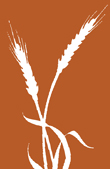
Atchison County
Chanute
Coffeyville
Derby
Fairway
Gardner
Junction City
Johnson County Parks and Recreation District
Lansing
Leavenworth County
Leavenworth
Leawood
McPherson
Merriam
Mission
Ottawa
Shawnee
Winfield
The Kansas Eastern Region Insurance Trust provides a
self-insured workers compensation program for local cities and counties.
Tom Brown, Chair
Mayor
City of McPherson, 620-245-2535
Jamie Chism,1st Vice Chair
Human Resources Director
City of Winfield, 620-221-5510
Nic Sanders, 2nd Vice Chair
Human Resources Director
City of Leawood, 913-663-9105
KERIT QUARTERLY is produced at Mid-America Regional Council. Contact Laura Bogue, editor, at 816-701-8269.
 Active shooter training presentation
Active shooter training presentation
At the March 8 KERIT trustee meeting, Chief Dan Field from the Johnson County Park & Recreation District provided a training session on active shooter situations. He showed a PowerPoint presentation and discussed the profile of an active shooter, steps in safely responding in an active shooter situation, responding appropriately when law enforcement officials arrive on the scene, and the need for training, planning and practice for active shooter scenarios.
Chief Field also showed a video entitled RUN. HIDE. FIGHT.® Surviving an Active Shooter Event created by the city of Houston, which is available on YouTube.
Following the video, Chief Field answered questions from the members and encouraged each member to have a training session with employees. Chief Field is willing to present on this topic to agencies in the Kansas City metropolitan area as his time permits. For information, contact Johnson County Park Police Headquarters at 913-438-7275.
KERIT Board elects new officers
Every year, The KERIT Board nominates individuals to the positions of chair, 1st vice chair and 2nd vice chair. This year, the nominating committee nominated the following individuals:

This slate of candidates was presented at the March meeting and was approved by the trustees. The chair runs the meetings and in his absence the 1st vice chair will take on meeting duties. Administrative decisions are typically shared among the three positions, and the 1st vice chair and 2nd vice chair may lead committees.
The KERIT board would like to thank Marilynn Evenson for her service as 2nd vice chair. Marilynn opted out of further service as an officer at this time, but will stay involved as the chair of the loss control committee and will also serve on the bylaws task force.
KERIT welcomes new trustees
Four new trustees have joined the board since the first of the year: Trisha Purdon from Coffeyville, Shawna Settles from Junction City, Jim Forge from Leavenworth and Will Crow from Winfield. Three of them attended a new trustee orientation before the March meeting to learn more about KERIT and their roles as trustees.
2015 PLUS Program scores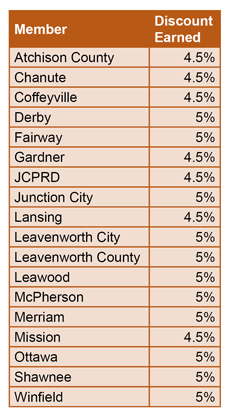
KERIT is pleased to announce that the majority of the membership has attained the highest award of 10 total points, a score which earns these members up to a 5 percent premium discount. To the right are the KERIT members' PLUS discounts. KERIT congratulates each member entity and thanks you for your hard work and dedication to the safety and health of your employees.
The PLUS Program Scorecard comprises nine components to establish measurable guidelines that help KERIT members achieve their goal of improved loss control. The areas emphasized in the scorecard are the activities that will have the greatest impact on the frequency of claims and the dollar amount of losses incurred. This is a 10-point scoring system, reflecting the nine major PLUS components.* Members receive one point for each component that is successfully completed, with these two exceptions:
- Component one — Timely Reporting of Claims (one point) and Claims Management (one point).
- Component nine — Other. In an effort to promote ongoing safety throughout the year, members are eligible to receive one additional point by implementing four out of six safety and health programs.
A total premium discount of 5 percent may be attained with 10 points earned.
*PLUS point components include: timely reporting of claims/claims management; post-offer physical assessment; wellness, physical fitness program for public safety personnel; facility inspections; safety committee; accident investigation; safety training/orientation; and other.
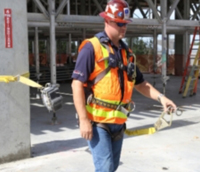 Rigging awareness training
Rigging awareness training
A rigging awareness training will be offered on May 3, 10 a.m. to 12 noon, at Sylvester Powell Jr. Community Center, 6200 Martway, Mission, Kansas. All are welcome to attend the free, two-hour seminar, but seating is limited to 80 people, so please register to reserve your spot. Registration closes Friday, April 29 at 4 p.m. or when the class is filled.
The training will be led by Jim Leach, who has 45 years of experience with American Rigger’s Supply, Inc. He is a Crosby “authorized trainer” and has earned an NCCCO level 1 rigger certification. Materials and handouts will be provided.
Read more about the training here.
To register, contact Travis Bennett at tbennett@thomasmcgee.com or 816-294-4483.
Seven steps to integrate safety and health into business value
The following seven steps will help health and safety professionals adopt a system for measuring the performance of health and safety functions in the context of their value to an organization, and for communicating results to business and financial executives.
- STEP 1: Identify the organization’s value drivers. “Value drivers” are the specific values that steer an organization’s overall business strategy and decision-making processes. For example, providing public safety services without interruption is a primary value driver for local governments.
- STEP 2: Identify injury and illness costs. Once the values that drive your organization are identified, the next step is to conduct a form of financial “hazard analysis” or an inventory of health and safety-related losses or costs that devalue the organization. Injuries and illnesses are clearly losses to an organization. OSHA’s Safety and Health Management Systems eTool can help estimate the annual cost of accidents at the workplace.
- STEP 3: Identify investments in health and safety activities. In this step, the goal is to view health and safety activities as investments instead of costs. An accident with injury is a cost. Accident prevention is an investment with benefits in cost control, compliance, risk and reputation.
- STEP 4: Link health and safety functions to the value drivers. This step helps identify the links between specific health and safety functions and the core business values of the organization. The connections will vary depending on a particular organization’s health and safety activities and core business values.
- STEP 5: Measure Business Value Performance. Once the connections between health and safety functions and the organization’s business values are made, the health and safety professional can choose the means to measure health and safety performance in the context of business values, and evaluate and enhance health and safety performance (e.g., streamline, innovate, improve processes) in such a context.
- STEP 6: Communicate results with your employees. Explain what you are doing to control costs, comply with regulations, support business initiatives, and protect and enhance your jurisdiction’s reputation.
- STEP 7: Follow up. Following up is like maintenance activities — vitally important to the health of the company, but often ignored. Follow up is the key to getting upper management to accept the business case for health and safety in the long term.
The benefits of an organization’s health and safety functions and performance are often undervalued due to communication barriers between health and safety professionals and executive management, and a lack of standard metrics for evaluating all aspects of health and safety performance. However, this situation is improving with the advent of health and safety business value metrics and well-organized strategies for using them.
Resources: GEMI. Clear Advantage: Building Shareholder Value. Washington, DC, February 2004; pp. 10, 26-32.
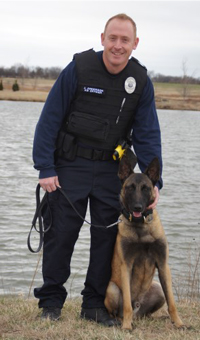 Zeus the police dog
Zeus the police dog
Zeus, a Belgian Malinois, is the newest member of the Gardner Police Department and supports the Patrol Division in narcotic detection and patrol operations. Gardner Police Officer James Anderson serves as Zeus’ handler and the pair completed a 30-day training in Texas. The team continued to train locally, obtaining national certification in narcotic detection and patrol operations. Zeus achieved a perfect score during his narcotics detection certification test and received a Level 2 Certification, the highest national certification awarded.
“As a police dog, Zeus’ first priority is to protect his handler,” Chief James Pruetting said. “We want to minimize the chance of an accidental bite to someone. Our own officers will not be able to touch or pet Zeus without the handler’s permission.” Zeus is expected to serve in this job for eight years. Once he is retired, he will remain with Officer Anderson who will train him to become a domesticated pet.
 Acclimate seasonal workers to prevent heat illness
Acclimate seasonal workers to prevent heat illness
Heat-related injuries and fatalities are always a risk in the Midwest’s unpredictable summers. Soaring summer temperatures can take a toll on outdoor workers, and new workers are especially at risk for heat illness.
Seasonal workers can be considered new even if they have been working every season for several years. Gradually increasing the workload and giving workers time to acclimate allows them to build tolerance to the heat. This is critically important for workers who are new to working outdoors in the heat, who have been away from working in the heat for a week or more, or who are working at the beginning of a heat wave. Visit OSHA's Heat Illness Prevention page for more information.
OSHA’s Heat Safety Tool allows you to have additional safety information available on your cellphone. The app allows workers and supervisors to calculate the heat index for their worksite and, based on the heat index, displays a risk level to outdoor workers. The app can give reminders about the protective measures that should be taken at that risk level, such as drinking enough fluids, scheduling rest breaks, planning for and knowing what to do in an emergency, adjusting work operations, gradually building up the workload for new workers, training on heat illness signs and symptoms, and monitoring each other for signs and symptoms of heat-related illness.
How to minimize hazards while performing tree care work 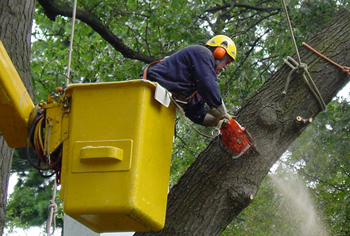
For those who perform tree care work, OSHA recently released a Hazard Bulletin that focuses on hazards from falls and falling objects in the industry. The bulletin identifies the hazards that can contribute to injuries and fatalities, and describes the safety measures workers can use to stay safe.
Fortunately, there are precautions you can take to minimize hazards in this dangerous line of work.
- Always assess the worksite for fall and falling object hazards before beginning the job.
- Have a qualified arborist survey the site for possible hazards related to tree structure.
- Determine whether rigging can be used safely.
- If ladders or aerial lifts are needed, make sure workers are trained on proper use.
- Always use the proper personal protective equipment (PPE) for the job.
- If workers cannot remain at least 10 feet from power lines, contact the local utility company to de-energize and ground the lines.
